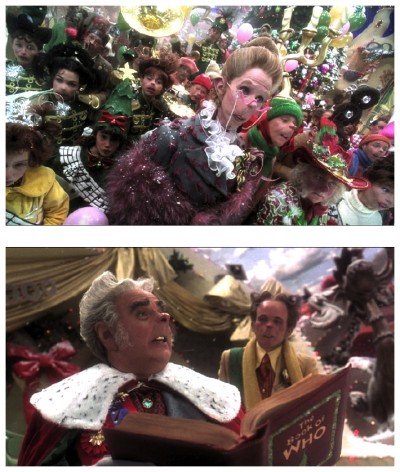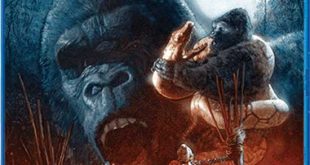“Rejected by the Whos as a child and living in spiteful seclusion for most of his life, the Grinch has always hated the citizens of Whoville. That especially goes for Christmas with the Whos noise, phony sentiment and wasteful materialism. When little Cindy Lou Who’s attempt to transcend the festivities’ empty commercialism by inviting the Grinch ends with his public humiliation, the Grinch hatches upon on his supreme scheme to ruin the holidays.” (courtesy IMDB)
REVIEW:
A snowflake wafts through space and the curious camera-eye zooms in. Like that poetic eternity in a grain of sand, its interior – a catacomb of jagged ice blocks and glittering ice crystals – opens onto a God’s-eye view of sunlit skies, swirling curlicue clouds and soaring snow-covered peaks. The camera swoops down to a village decked in Christmas finery, a cozy place of cheer amidst an icy wonderland. But above the village looms a strangely lopsided mountain with a foreboding cave, a dark hole of gloom. Thus begins How The Grinch Stole Christmas (2000), a Universal Pictures holiday release. The only other adaptation of the beloved 1957 illustrated children’s story by the late Theodore Geisel (aka Doctor Seuss) had been the Chuck Jones animated television version – a perennial favourite for more than four decades – which was faithful to the fable of the cranky cave-dwelling Grinch who steals the presents and the trappings of the town’s yuletide celebration, only to discover that the Whos of Whoville still greet Christmas morning with their holiday spirit intact.
 Enter Ron Howard, middle-America’s favourite dramedy director, and his extremely expensive leading man Jim Carrey, who Howard seemingly expected to carry the entire project. The result was a box-office goliath – thanks mostly to the holiday timing and an aggressive marketing campaign – that struggles to hold up just a decade later. You have to wonder when Howard has ever displayed the sort of directorial vision that the story deserved. In Parenthood (1989) perhaps? What about EdTV (1999)? True, he was at the helm of Willow (1988), but he clearly forgot to use that experience here. The story is unfortunately altered and expanded to include an extra trip to Whoville by the Grinch and background on him to artificially elongate the screenplay, but it’s the whole look and feel of the Whos and Whoville that’s so awkward and synthetic that the viewer is never drawn in.
Enter Ron Howard, middle-America’s favourite dramedy director, and his extremely expensive leading man Jim Carrey, who Howard seemingly expected to carry the entire project. The result was a box-office goliath – thanks mostly to the holiday timing and an aggressive marketing campaign – that struggles to hold up just a decade later. You have to wonder when Howard has ever displayed the sort of directorial vision that the story deserved. In Parenthood (1989) perhaps? What about EdTV (1999)? True, he was at the helm of Willow (1988), but he clearly forgot to use that experience here. The story is unfortunately altered and expanded to include an extra trip to Whoville by the Grinch and background on him to artificially elongate the screenplay, but it’s the whole look and feel of the Whos and Whoville that’s so awkward and synthetic that the viewer is never drawn in.
 Both the original story and the animated television special had kept the Grinch’s hatred of Christmas and those Whos down in Whoville veiled in mystery, merely noting as a possible for motive his rumoured two-sizes-too-small heart. But the big-screen version would reveal the ‘why’ of it all, at the same time conjuring up an entire world, a population of Whos plus one Grinch – designs all inspired by Seuss’s quirky beguiling imagery. For everyone involved, the production would prove to be one of the most ambitious in recent memory. Production designer Michael Corenblith – a Ron Howard veteran with credits on both Apollo 13 (1995) and Ransom (1996) – erected lavish sets, ranging from the Grinch’s lair atop Mount Crumpit to downtown Whoville, that filled Universal Studios’ biggest soundstages.
Both the original story and the animated television special had kept the Grinch’s hatred of Christmas and those Whos down in Whoville veiled in mystery, merely noting as a possible for motive his rumoured two-sizes-too-small heart. But the big-screen version would reveal the ‘why’ of it all, at the same time conjuring up an entire world, a population of Whos plus one Grinch – designs all inspired by Seuss’s quirky beguiling imagery. For everyone involved, the production would prove to be one of the most ambitious in recent memory. Production designer Michael Corenblith – a Ron Howard veteran with credits on both Apollo 13 (1995) and Ransom (1996) – erected lavish sets, ranging from the Grinch’s lair atop Mount Crumpit to downtown Whoville, that filled Universal Studios’ biggest soundstages.
 Special effects coordinator Allen Hall – an Oscar nominee for his work on Howard’s Backdraft (1991) – fielded an unusually large crew of fifty-eight technicians to handle the production’s ambitious on-set effects, and makeup guru Rick Baker not only transformed actor Jim Carrey into the title character – a huge undertaking in itself – but ground-out ninety different makeups each day for the large cast of Whos, making How The Grinch Stole Christmas the biggest makeup show ever, surpassing the benchmark Planet Of The Apes (1968) and its sequels. Despite the huge production values and obvious efforts of the technicians involved, within the first ten minutes you’ll be wishing somebody had given Tim Burton a shot at this project, because if anyone knows how to create entire worlds and stylised characters, it’s him. Just think of how weird the Whos, how menacing the Grinch, and how much more engaging the script could have been, instead of Howard’s soft accessible and ultimately insubstantial take.
Special effects coordinator Allen Hall – an Oscar nominee for his work on Howard’s Backdraft (1991) – fielded an unusually large crew of fifty-eight technicians to handle the production’s ambitious on-set effects, and makeup guru Rick Baker not only transformed actor Jim Carrey into the title character – a huge undertaking in itself – but ground-out ninety different makeups each day for the large cast of Whos, making How The Grinch Stole Christmas the biggest makeup show ever, surpassing the benchmark Planet Of The Apes (1968) and its sequels. Despite the huge production values and obvious efforts of the technicians involved, within the first ten minutes you’ll be wishing somebody had given Tim Burton a shot at this project, because if anyone knows how to create entire worlds and stylised characters, it’s him. Just think of how weird the Whos, how menacing the Grinch, and how much more engaging the script could have been, instead of Howard’s soft accessible and ultimately insubstantial take.
 In the context of a weak story and awful sets, Carrey shines just that much brighter. He sings, dances, and packs in some fantastic physical humour and one-liners. The scene in which he’s trying to decide whether to go to Whoville to accept the Christmas Cheerleader award and his near destruction of the town features some of the best physical comedy and slapstick since Jerry Lewis at his peak. The injection of Doctor Seuss’s rhymes into some of Carrey’s dialogue is a little ill-fitting, but it’s his rendition of You’re A Mean One Mister Grinch is the only tune in the movie worth a damn. The late great Roger Ebert noted that “Carrey works as hard as an actor has ever worked in a movie, to small avail. He leaps, he tumbles, he contorts, he sneers, he grimaces, he taunts, he flies through the air and tunnels through the garbage mountain, he gets stuck in chimneys and blown up in explosions. His Grinch, with his pig-snout nose and Mister Hyde hairdo, looks more like a perverse wolfman than the hero of a comedy. Adults may appreciate Carrey’s remarkable performance in an intellectual sort of way and give him points for what was obviously a supreme effort.”
In the context of a weak story and awful sets, Carrey shines just that much brighter. He sings, dances, and packs in some fantastic physical humour and one-liners. The scene in which he’s trying to decide whether to go to Whoville to accept the Christmas Cheerleader award and his near destruction of the town features some of the best physical comedy and slapstick since Jerry Lewis at his peak. The injection of Doctor Seuss’s rhymes into some of Carrey’s dialogue is a little ill-fitting, but it’s his rendition of You’re A Mean One Mister Grinch is the only tune in the movie worth a damn. The late great Roger Ebert noted that “Carrey works as hard as an actor has ever worked in a movie, to small avail. He leaps, he tumbles, he contorts, he sneers, he grimaces, he taunts, he flies through the air and tunnels through the garbage mountain, he gets stuck in chimneys and blown up in explosions. His Grinch, with his pig-snout nose and Mister Hyde hairdo, looks more like a perverse wolfman than the hero of a comedy. Adults may appreciate Carrey’s remarkable performance in an intellectual sort of way and give him points for what was obviously a supreme effort.”
 Critic Stephanie Zacharek wrote, “Carrey pulls off an admirable impersonation of an animated figure. Behind those sadistic yellowy eyes and that rangy green fur, he gets the facial tics and the precise slippery mannerisms of Jones’ Grinch just right. It’s fine as mimicry goes, but mimicry isn’t the best playground for comic genius. Shouldn’t we be asking more of a man who’s very likely the most gifted comic actor of his generation? Carrey’s rubbery grace marks him as the most physically gifted comedian since Jerry Lewis, and his dotty free associations, here and in just about every picture he’s done, from The Mask (1994) to Dumb And Dumber (1994) to Me Myself And Irene (2000), suggest a mind that’s mosquito-zapper quick.” If you couple Carrey’s performance with the still applicable (yet rarely adhered to) underlying message of Christmas not being about gifts, you can go halfway to forgiving the project’s glaring shortcomings. After this experience, I would have expected Doctor Seuss’s widow to keep the rest of his stories out of the hands of Hollywood so that kids could experience them as intended, but no.
Critic Stephanie Zacharek wrote, “Carrey pulls off an admirable impersonation of an animated figure. Behind those sadistic yellowy eyes and that rangy green fur, he gets the facial tics and the precise slippery mannerisms of Jones’ Grinch just right. It’s fine as mimicry goes, but mimicry isn’t the best playground for comic genius. Shouldn’t we be asking more of a man who’s very likely the most gifted comic actor of his generation? Carrey’s rubbery grace marks him as the most physically gifted comedian since Jerry Lewis, and his dotty free associations, here and in just about every picture he’s done, from The Mask (1994) to Dumb And Dumber (1994) to Me Myself And Irene (2000), suggest a mind that’s mosquito-zapper quick.” If you couple Carrey’s performance with the still applicable (yet rarely adhered to) underlying message of Christmas not being about gifts, you can go halfway to forgiving the project’s glaring shortcomings. After this experience, I would have expected Doctor Seuss’s widow to keep the rest of his stories out of the hands of Hollywood so that kids could experience them as intended, but no.
 Unfortunately, the so-called special features on the DVD I recently viewed were just as mediocre as the film itself. Spotlight On Location is a throwaway featurette containing rather blurry footage of director Ron Howard dressed up like the Grinch and producer Brian Grazer‘s hair, which looks like he’s stuck a fork into a live power socket. Furthermore, there is no ‘select’ option on the Deleted Scenes which means you have to watch all or none of these five scenes, the last of which is the best, in which the Grinch checks out the Whos ‘boo-hoo’ reactions to his Christmas thievery. You wouldn’t necessarily get it from watching the movie, but Who School explains how a lot of effort went into designing the body language of the Whos. The stunt coordinator worked with Cirque Du Soleil and hired a bunch of the more malleable circus performers to come in and act Who-like, which basically means a lot of exaggerated falls and spills.
Unfortunately, the so-called special features on the DVD I recently viewed were just as mediocre as the film itself. Spotlight On Location is a throwaway featurette containing rather blurry footage of director Ron Howard dressed up like the Grinch and producer Brian Grazer‘s hair, which looks like he’s stuck a fork into a live power socket. Furthermore, there is no ‘select’ option on the Deleted Scenes which means you have to watch all or none of these five scenes, the last of which is the best, in which the Grinch checks out the Whos ‘boo-hoo’ reactions to his Christmas thievery. You wouldn’t necessarily get it from watching the movie, but Who School explains how a lot of effort went into designing the body language of the Whos. The stunt coordinator worked with Cirque Du Soleil and hired a bunch of the more malleable circus performers to come in and act Who-like, which basically means a lot of exaggerated falls and spills.
 Set Decoration talks with with set designer Meredith Boswell, who claims they tried not to make it look like Santa’s Workshop but, if that’s true, they failed miserably. When Doctor Seuss’s widow Audrey says, “They made it perfect,” you have to wonder what medication she’s on, because no film costing US$240 million should look so much like an uninspired shopping mall display. In Visual Effects, coordinator Kevin Mark dishes out the goods on some of the six hundred visual effects used in the movie. He shows you the steps taken to fill-in the blue screen with multi-layered computer-generated backgrounds, as well as the Who Construction Kit his team developed to create computer-generated Whos to mix in with the real ones, but the best bit is the footage of his team trying to film the Grinch’s overloaded sleigh coming down a mountain, then ditching all but four shots and resorting to CGI for the rest.
Set Decoration talks with with set designer Meredith Boswell, who claims they tried not to make it look like Santa’s Workshop but, if that’s true, they failed miserably. When Doctor Seuss’s widow Audrey says, “They made it perfect,” you have to wonder what medication she’s on, because no film costing US$240 million should look so much like an uninspired shopping mall display. In Visual Effects, coordinator Kevin Mark dishes out the goods on some of the six hundred visual effects used in the movie. He shows you the steps taken to fill-in the blue screen with multi-layered computer-generated backgrounds, as well as the Who Construction Kit his team developed to create computer-generated Whos to mix in with the real ones, but the best bit is the footage of his team trying to film the Grinch’s overloaded sleigh coming down a mountain, then ditching all but four shots and resorting to CGI for the rest.
 The most interesting special features are Makeup Design And Application, which is mostly a nice chat with makeup maestro Rick Baker explaining how Carrey spent ninety-two torturous days in the Grinch costume, claiming the experience taught him patience, and Outtakes, which is a genuinely funny gag reel consisting mostly of Carrey apologising for screwing up, minor problems with Max the dog, and various characters’ fake teeth coming undone. The crown jewel comes when Carrey, out of frustration, bites Jeffrey Tambor‘s fake nose off. The bottom line is the story of How The Grinch Stole Christmas is limp and the sets don’t work, but Carrey’s performance is awesome. If you have any coal-deserving kids, it’s a must-have if only to get them off your back for a couple of hours. Keep that thought in mind until we meet again next week on Horror News when I have another opportunity of inflicting a pain beyond pain, an agony so intense it shocks the brain into instant mashed potato! Toodles!
The most interesting special features are Makeup Design And Application, which is mostly a nice chat with makeup maestro Rick Baker explaining how Carrey spent ninety-two torturous days in the Grinch costume, claiming the experience taught him patience, and Outtakes, which is a genuinely funny gag reel consisting mostly of Carrey apologising for screwing up, minor problems with Max the dog, and various characters’ fake teeth coming undone. The crown jewel comes when Carrey, out of frustration, bites Jeffrey Tambor‘s fake nose off. The bottom line is the story of How The Grinch Stole Christmas is limp and the sets don’t work, but Carrey’s performance is awesome. If you have any coal-deserving kids, it’s a must-have if only to get them off your back for a couple of hours. Keep that thought in mind until we meet again next week on Horror News when I have another opportunity of inflicting a pain beyond pain, an agony so intense it shocks the brain into instant mashed potato! Toodles!
 Horror News | HNN Official Site | Horror Movies,Trailers, Reviews
Horror News | HNN Official Site | Horror Movies,Trailers, Reviews







